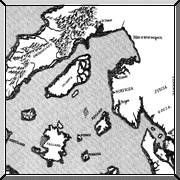 Nicolo Zeno
"Junior", the author of the Zeno Narrative as published in
1558, was born in Venice in 1515. The Zeno publication was the young
Zeno's efforts to recount the discoveries and travels of his Zeno
ancestors, as transcribed from letters between Nicolo Zeno the
Chevalier (133?-1395), his brother Carlo Zeno "The Lion" (?-1418),
and Nicolo's son Antonio (?-1405). Being the
great-great-great-grandson of Antonio Zeno, the letters came into his
hands after the death of his father. He then put the letters "in
order", "...that such an important memorial should not be lost..."
Nicolo Zeno
"Junior", the author of the Zeno Narrative as published in
1558, was born in Venice in 1515. The Zeno publication was the young
Zeno's efforts to recount the discoveries and travels of his Zeno
ancestors, as transcribed from letters between Nicolo Zeno the
Chevalier (133?-1395), his brother Carlo Zeno "The Lion" (?-1418),
and Nicolo's son Antonio (?-1405). Being the
great-great-great-grandson of Antonio Zeno, the letters came into his
hands after the death of his father. He then put the letters "in
order", "...that such an important memorial should not be lost..."
The Zeno Narrative told about many things including a survey to make a map of Greenland in about 1393. This survey was conducted by Nicolo Zeno, and later by Prince Henry Sinclair's ships. This Zeno "Map of the North" proved to be the most accurate map in existence for the next 150 years!
From the pages of the Zeno's Narrative and Map, a chronicle of Antonio Zeno, a Venetian Sea Captain in the employ of a Scottish Prince, Henry St.Clair (Sinclair), we also see the account Captain Zeno relates about how his father met Prince Henry, how he (Antonio) later came into the employ of Prince Sinclair, and about the experiences of a voyage of exploration and colonization to North America in 1398.
"...Sinclair happened to be in the Faeroe Islands, which were part of his earldom in 1390, when he heard a ship had been wrecked and, since shipwrecks were fair game for pillage at the time, the local fishermen were attacking the crew. Sinclair rescued the mariners, and discovered they were Venetians. Their commander, Nicolo Zeno, was a brother of the most famous admiral of the time, Carlo Zeno. Sinclair hoped to dominate the northern seas, and promptly appointed Nicolo commander of his fleet."
The meeting of Captain Nicolo was most timely. He shared with Prince Henry the Zeno family method of constructing and adapting a lightweight cannon for use on board ship. One that could be pivoted and aimed at the enemy without the maneuvering of the ship. Captain Nicolo was also well versed in the latest navigational theories and cartographic skills. After Nicolo's death, Sinclair appointed Zeno's son Antonio, as fleet commander.
Not only did the Zeno Map chart the sea with uncanny precision, it also showed certain landmarks. For example, it illustrated two cities in Estotilanda (Nova Scotia), possibly founded by Sinclair at Louisburg Harbor and St. Peter's. A castle or fortification was also shown. There is speculation that Zeno based his map upon a much more ancient map, coming from the Templars in the Middle East and carried in secrecy by them for safekeeping in Rosslyn Castle until Price Henry commissioned its update by Zeno.
From "The Westford Knight Saga" we read:
"Prince Henry Sinclair, The Second Earl of Orkney, his first cousin Sir James Gunn of Thurso, and Captain Antonio Zeno departed the Orkney Islands early in the year 1398 and sailed to what is now known as Greenland. After leaving a small colony the voyagers sailed on to what is now Nova Scotia where the voyagers landed to spend the winter. They were welcomed by the local indigenous people as White Gods, "Glooscap", legendary figures. The legend of these people, who were called the Micmacs, is similar to the Mayan myth of Quetzalcoatl, a people living thousands of miles south. However, that is where the similarities end. These newcomer's did not bring conflict nor did they bring destruction. It was recorded that the voyagers taught the arts of fishing and farming to the Micmacs. Prince Henry Sinclair and Sir James Gunn's dealings with the Micmacs left such a favorable impression that they were remembered by them in legend and song. In the Spring the explorers sailed down the coast to what is now known as Westford, Massachusetts and found the Merrimack River. They explored inland until they came upon a small tributary now known as the Stony River. A short way up the Stony is where they made anchorage just a short distance from our present day Westford, Massachusetts. Several large engraved mooring stones have been found along the banks indicating that as many as twelve long boats could have been tied up here. While there in a unrecorded incident, Sir James Gunn died. Although how he died is not recorded in the Zeno narrative, the broken sword does indicate that he died in battle."
Soon you will have the opportunity to participate in the 600th Anniversary celebration of Prince Henry's exploration of North America. His remarkable achievements carry many symbolic messages, which are meaningful to us today. He had the skill and the courage to sail to "the ends of the earth" in pursuit of his beliefs and to establish peaceful relations with the people he encountered. Henry was admired and his leadership was followed. Since he did not seek personal fame, his accomplishments have nearly slipped from view. Join the crusade now to celebrate the Six Hundredth Anniversary of Prince Henry Sinclair, which will occur in 1998.
For further information, check the following links:
Prince Henry & 600th Anniversary Celebration
Sinclair (St.Clair) Clan Home Page
Designed by: John P. St.Clair
References
"Clann Gunn Society of North America." http://www.nsynch.com/~clangunn/knight.html. (11 Nov 1997).
Pohl, Frederick J. (1974). Prince Henry Sinclair - His Expedition to the New World in 1398. New York: Clarkson N. Potter, Inc.
"The Westford Knight Saga." http://www.icubed.net/usr/dmartin/westford.html. (11 Nov 1997)